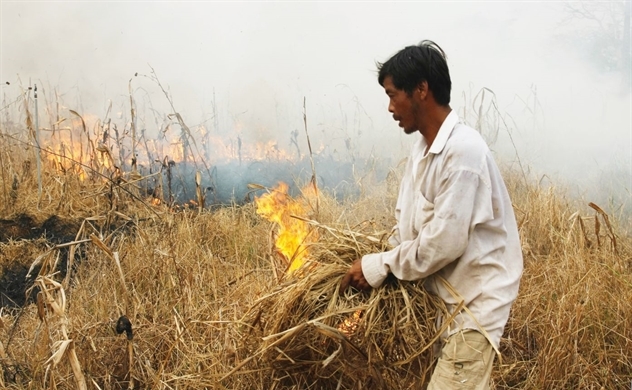[ad_1]
VietNamNet Bridge – At the Lagos Conference in 2016, Vietnam was reported as ranking 10th worldwide in air pollution.

Farmers burn straw after crop
And based on figures provided by WHO and NASA, Yale University compiled the Environmental Performance Index – EPI 2016 for 180 countries and territories. Vietnam ranked 170th out of 180 countries in terms of environmental quality.
The fine dust concentration was reported at 50.5 mg per cubic meter in Hanoi and 28.3 mg per cubic meter in HCM City, which meant that Hanoi had 282 polluted days a year in and HCM City 175 days.
Experts say agricultural waste is also a big problem which needs to be settled.
In 2017, total exported agricultural value was $36.37 billion, higher than the target of $32-33 billion set by the government.
In the same year, a World Bank report was released on the overview of agricultural pollution in Vietnam, pointing out that key farm produce, including pigs, poultry, seafood and food crops, on one hand made great contribution to economic development, but on the other hand, led to increased pollution.
|
A World Bank report was released on the overview of agricultural pollution in Vietnam, pointing out that key farm produce, including pigs, poultry, seafood and food crops, on one hand made great contribution to economic development, but on the other hand, led to increased pollution. |
The damages caused by pollution in Vietnam are estimated at 5 percent of GDP, or $10 billion a year.
Many farmers overuse animal feed and pesticides, and don’t treat farm waste. They usually burn agricultural waste.
In 2017, Vietnam had 27.4 million pigs, 385.6 million fowl and 8.09 million cows and buffaloes.
The World Bank report showed that the cattle waste generated each year amounts to nearly 80 million tons. This is a mixture of nutrients, pathogens and volatile compounds that seriously affect the quality of air and water.
In pig farming, about 70-90 percent of the nitrogen, minerals (phosphorus, potassium, magnesium and others) and other heavy metals contained in livestock feed are released into the environment.
The ammonia concentration in the exhaust gas from pig farms in the northern region is 7-18 times higher than the permitted level, while hydrogen sulfide is 5-50 times higher.
World experts conclude that animal husbandry is one of the major causes of climate pollution in Vietnam and the fastest-growing greenhouse gas emissions source.
A survey found that 50-60 percent of rice growers use pesticide volume higher than suggested because they believe higher volume will bring more efficiency.
At least 98 percent of farmers in the Mekong Delta burn straw after the winter-spring crop, which releases chemical compounds into the air.
RELATED NEWS
Agriculture Ministry urges use of organic fertilizer to ‘clean’ land
New bio-based waste treatment developed by Vietnamese scientists
Mai Nam
[ad_2]
Source link
